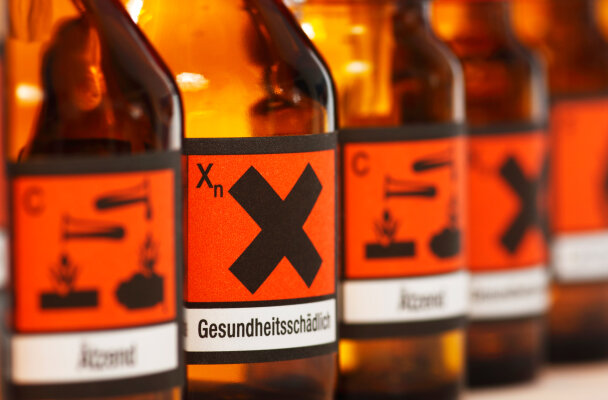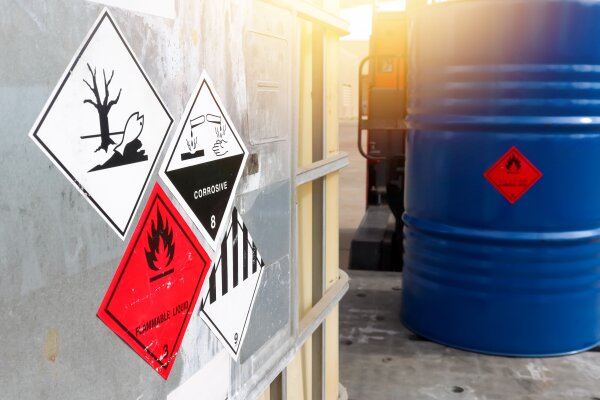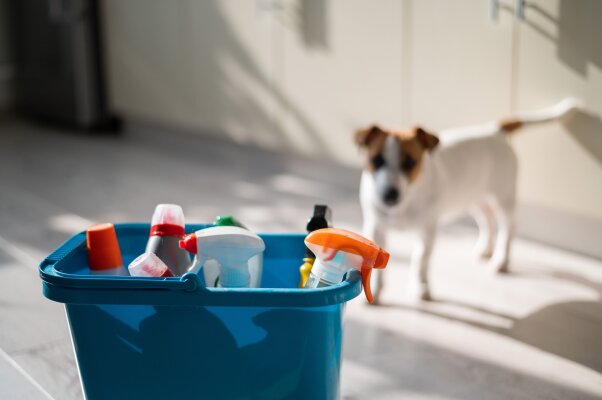Disinfectants: types, effect and selection
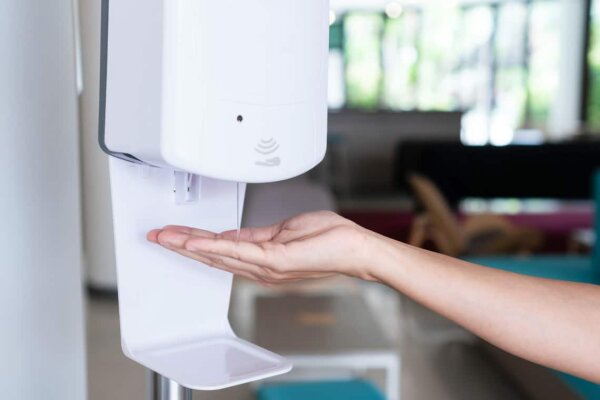
Whether bacteria, viruses or fungal spores: microorganisms surround us constantly. Often they are harmless, but in some cases they contribute to the spread of disease. To counteract this, disinfectants are used. In this article, we will focus on the different types of disinfectants: What are their ingredients? What do they work against? And what to look for in the application?
What does disinfection mean in detail?
In short, disinfectionkills or inactivates various germs. The aim is to reduce the number of pathogens on a surface to such an extent that infection is ruled out.
The difference between disinfectionand sterilizationlies in the number of remaining germs. Disinfection is said to occur when the pathogens are reduced by an order of magnitude of 10-5. This means that out of 100,000 germs, one is still left after disinfection. In theory, sterilization is intended to achieve complete sterility. In practice, however, a germ reduction by a factor of 10-6 is considered sufficient for sterilization.
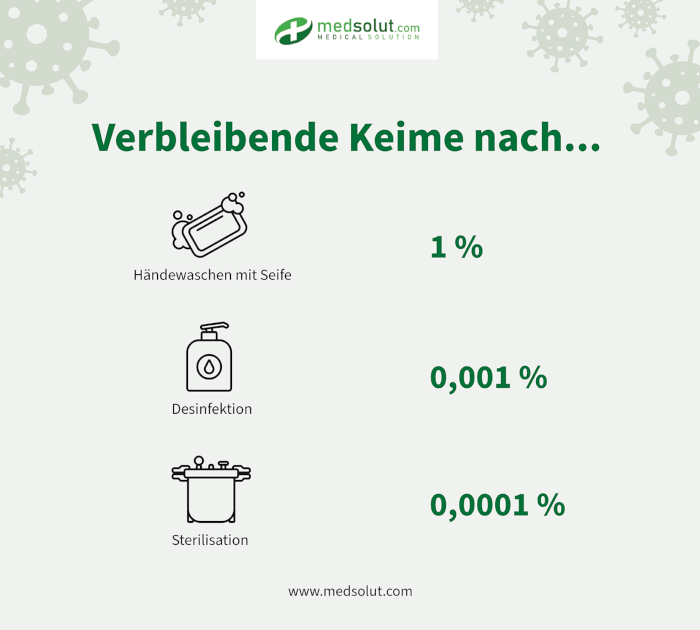
Requirements for disinfectants
Disinfectants should therefore on the one hand kill the pathogens as efficiently as possible – but on the other hand they should not damage the body parts and surfaces concerned. Overall, good disinfectants are characterized by the following properties, among others:
- fast and thorough germ reduction
- good compatibility with skin, mucous membrane, wounds, materials (depending on application)
- little odor development
- Long shelf life
- good environmental compatibility (biodegradable)
- low systemic toxicity (i.e. poisoning effect on the whole body).
- as little loss of effect as possible due to protein or soaps
- sufficient penetration depth
Depending on the intended use, the disinfectant must be effective against certain groups of pathogens – e.g. specific viruses or bacterial spores. Read more about the different types of disinfectants in the following paragraphs.
Types of disinfection: How does disinfectant work?
The effect of disinfectants is based on various chemical or physical processes that result in germs dying or no longer being able to multiply. The main types of disinfection are:
- Protein denaturation: Here, protein building blocks of microorganisms are attacked, for example the protein envelope of viruses.
- Oxidation: Pathogens are inactivated or killed by reaction with oxygen.
- chemical reaction with the nucleic acids:This destroys or alters the genetic material of the microorganisms so that they cannot reproduce further.
- Enzyme inhibition: This prevents necessary metabolic processes of the pathogens.
In addition, agents to reduce surface tension are often added – for example surfactants, which are also contained in soap. This supports the effect of the disinfection.
Non-chemical disinfection methods
Disinfectantis usually understood to mean a liquid for chemical disinfection that uses the mechanisms of action discussed above. In addition, there are some non-chemical disinfection methods that kill pathogens by physical means. These include:
- Heating: This is used, for example, in the preservation of milk. However, germ reduction by heat also plays an important role in sterilization (for example, with laboratory autoclaves).
- Irradiation: Disinfection can also be achieved by means of UV radiation, gamma radiation or ionizing radiation. Such methods are used, for example, in laboratory work with PCR workbenches.
- Mechanical methods:Microorganisms can also be reduced by mechanical destruction, such as cell disruption.
Disinfectant types: classification according to efficacy
Especially since the outbreak of the Corona pandemic, it is important to know: Not every disinfectant is effective against viruses. This is because, depending on the ingredients used, the agent has an effect against some microorganisms – but not against some. Depending on their spectrum of activity, the following types of disinfectants can be distinguished:
Bactericidal
Disinfectants that act against bacteria are called bactericidesor bactericidal. These includealcohols, phenols and chlorine. If an agent is bacteriostatic, then it only inhibits the multiplication of bacteria, but does not kill them.
Virucidal
If you want to protect yourself from viral diseases, you need a disinfectant with the label “virucidal”. However, not all viruses are the same! This is because some active ingredients are only effective against so-called enveloped viruses. Therefore, one distinguishes here once again in:
- Limited virucidal: Effective against enveloped viruses, including herpes, measles and coronaviruses.
- limited virucidal PLUS:Effective against enveloped viruses and additionally adeno-, noro- and rotaviruses.
- virucidal:effective against enveloped and non-enveloped viruses, such as hepatitis B or human papilloma viruses.
Fungicide
Fungicidal disinfectants are effective against existing fungal cultures – but not against fungal spores. To do this, as explained in the next point, you need a sporicide.
Sporicidal
Active ingredients that render fungal or bacterial spores incapable of germination are known as sporicides. Since spores are often more resistant than their “adult” appearance, only selected disinfectants are classified as sporicidal. These include, for example, reactive oxidants such as chlorine, peracetic acid, sodium hypochlorite, hydrogen peroxide or ozone.
Conveniently, most disinfectants are multitoxic– that is, they work against different types of pathogens at the same time. Alcohols are suitable, for example, for combating bacteria, enveloped viruses and fungi.
Disinfectants against coronaviruses - what to look for?
Since the onset of the Corona pandemic, disinfectants have been ubiquitous. But beware: The quick grab for “disinfectant gel” from the drugstore is not always useful. This is because not all commercial disinfectant types are also effective against coronaviruses.
The “culprit” – i.e. the Sars-CoV-2 virus – is an enveloped virus. Accordingly, disinfectants with an effective range of “limited virucidal” are suitable for protecting against this. Alcohol-based solutions, such as those containing ethanol or isopropanol, are recommended for hand disinfection. Sodium hypochlorite, on the other hand, is not recommended as it is excessively irritating to the skin.
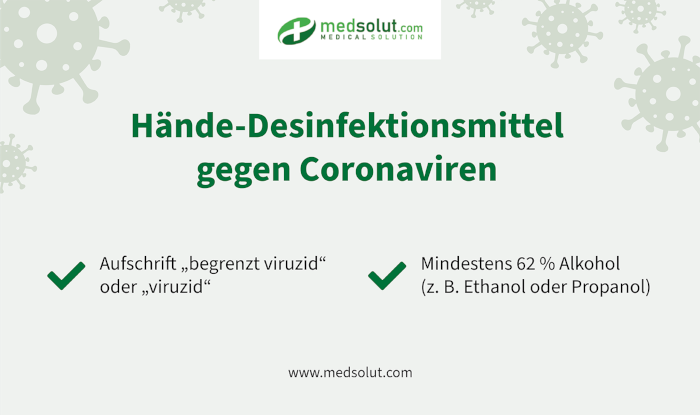
Disinfectant types: classification according to use
In addition to the classification according to area of action, disinfectants can also be classified according to their use. This is because different products must be used depending on whether the hands, the floor or surgical instruments are to be disinfected.
The following disinfectant types are relevant:
Hand disinfection
Hand disinfectants must be particularly well tolerated and areoften enriched with caring or re-lubricating substances. Alcohol is often used as the active ingredient, sometimes supplemented with sporicides such as hydrogen peroxide.
Skin disinfection
During operations, injections or other invasive procedures, the skin surface is disinfected to prevent germs from being carried inside the body.
As with hand disinfectants, alcohol-based solutions that are sprayed on or applied with swabs are also frequently used for this purpose. However, these do not contain any refatting ingredients.
Surface disinfection
Contaminated surfaces – e.g. floors, operating theater couches or toilets – are cleaned with surface disinfectant.
A distinction must be made here between spray and wipe disinfection. In principle, wipe disinfection is recommended, as small disinfectant droplets can get into the lungs when spraying.
Especially important: Check the compatibility of the agentwith the material to be cleaned. Agents containing alcohol cause stains on coated floors, for example.
Instrument disinfection
Disinfectants are also used in the reprocessing of medical instruments. Disinfection here can be done thermally by heating or thermochemically, which is a combination of heat and chemicals.
Laundry disinfection
Chemical laundry disinfectants are needed, for example, in the medical sector to ensure that textiles are hygienically clean even at lower temperatures (40-60 °C). Chlorine, peracids or aldehydes, for example, serve as active ingredients.
Water disinfection
The approved chemical disinfectants for drinking water in Germany are sodium and calcium hypochlorite, chlorine dioxide, chlorine and ozone. In addition, there are other methods of disinfection, such as boiling the water or UV irradiation.
For water treatment in the laboratory special pure and pure water systems are also used, which work with ion exchange, reverse osmosis and distillation.
Important:
Disinfectants should never be misappropriated – so do not use them in any area other than their intended use. For example, surface disinfectants can cause severe skin irritation.
Ingredients of the disinfectant types
The ingredients in the disinfectant depend on what purpose it serves. Depending on the type of disinfection, various disinfecting agents are combined and supplemented with other ingredients that make the product durable or protect the skin from drying out.
The ingredients of simple homemade hand sanitizer are for example:
- Ethanol: Has a disinfecting effect against bacteria, non-enveloped viruses and fungi
- Hydrogen peroxide: Additive to kill spores
- Glycerin: Moisturizing, is to prevent the hands from drying out
- Distilled water
However, depending on the type of disinfection, the composition can of course be quite different. The following table provides a brief overview of frequently used active ingredients.
| Active ingredient (group) | For disinfection of | Effective spectrum |
| Aledyhde | Instruments, surfaces | bactericidal, virucidal, fungicidal, conditionally sporicidal |
| Alcohols | Skin, surfaces, instruments | bactericidal, limited virucidal, fungicidal |
| Chlorine | Water, instruments | bactericide, virucide, fungicide, sporicide |
| Chlorhexidine | Skin (especially oral mucosa) | bacteriostatic, virostatic, fungistatic |
| Sodium hypochlorite | Surfaces, instruments, water, skin (not recommended) | bactericide, virucide, fungicide, sporicide |
| Octenidin | Skin (especially mucous membrane and wounds) | bactericidal, virucidal, fungicidal |
| Ozone | Water, instruments | bactericide, virucide, fungicide, sporicide |
| Peracetic acid | Surfaces, instruments | bactericide, virucide, fungicide, sporicide |
| Phenols | Skin, surfaces, instruments | bactericidal, fungicidal, some virucidal |
| Povidone-iodine | Skin (especially mucous membrane and wounds) | bactericide, virucide, fungicide, sporicide |
| Quaternary ammonium compounds | Skin | bactericidal, fungicidal, limited virucidal |
| Hydrogen peroxide | Surfaces, instruments, water, skin | bactericide, virucide, fungicide, sporicide |
Tested efficacy: lists from RKI, VAH and IHO
So how can you make sure to purchase an effective, appropriate disinfectant? Here it is best to resort to the recommendations of official bodies. The following institutions publish a list of tested disinfectants – including the recommended exposure time in each case:
- Robert Koch Institute (RKI)
- Association for Applied Hygiene (VAH)
- Hygiene and Surface Protection Industry Association (IHO)
By the way: To indicate which disinfectants are suitable for which purposes, the Robert Koch Institute divides disinfectants into groups A, B, C, and D. The disinfectant’s range of action can be divided into three groups:
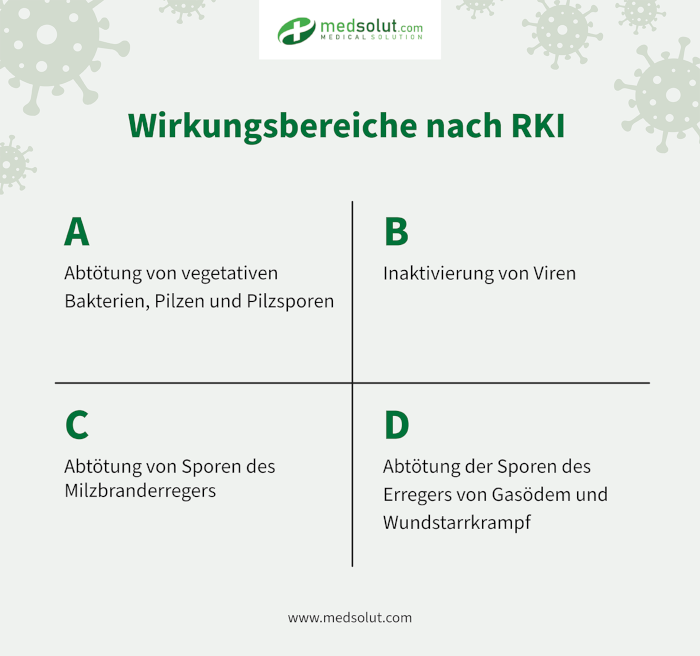
Application instructions for disinfectant types
To reliably prevent infections, however, it is not enough to select a suitable disinfectant: The correct application is just as important. In the following, we explain whatmust be observed when disinfecting hands and surfaces.
Hand disinfection
Basically important for any disinfection: Follow the manufacturer’s instructions. This concerns especially…
… the recommended amount per disinfection.
… the recommended exposure time.
… the correct concentration of the agent.
If, for example, one does not adhere to the necessary exposure time and rubs the hands only briefly (instead of about the usually recommended 30 seconds) – then the agent can not work thoroughly. As a result, too many microorganisms remain on the hands and there is a possible risk of infection.
The correct rub-in technique is particularly crucial for hand disinfection. This is the only way to ensure that all surfaces on the hand are covered.
In addition, hands should always be disinfectedin a dry state. Wet hands will dilute the disinfectant to the point that it may not be effective enough.
The following graphic shows at a glance what you need to pay attention to:
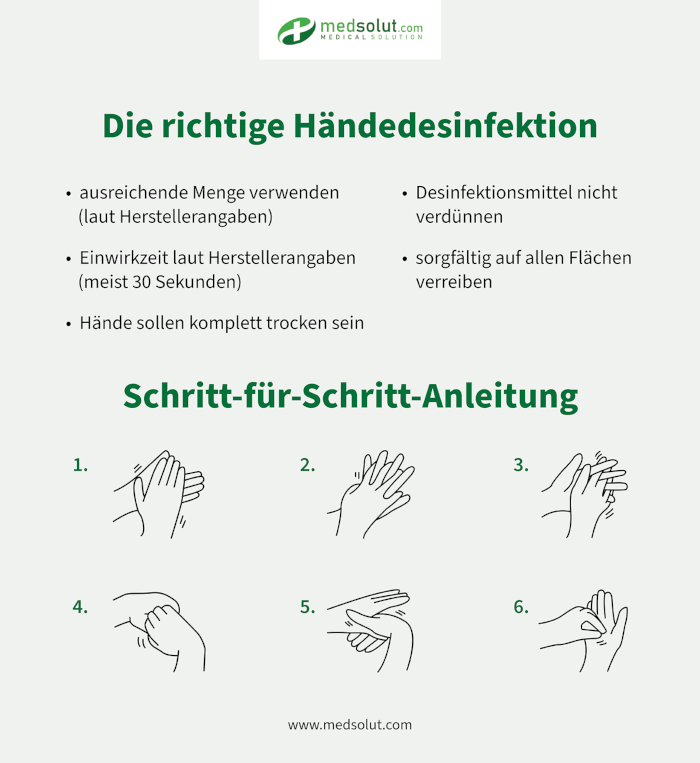
Surface disinfection
The same applies to surface disinfection: Observe the recommended concentration and exposure time according to the manufacturer’s instructions! For wipe disinfection,the surface must usually be properly wet– moistening is not sufficient here.
Speaking of wipe disinfection: If possible, this should be preferred to spray disinfection. This is because the fine spray mist can cause harmful substances to enter the lungs.
Gloves are recommended to protect the hands. Because surface disinfectant is not always well tolerated by the skin.
To ensure hygiene, the following instructions must also be observed:
- Use disposable wipes
- do not immerse used cloths in the agent again
If the surface comes into contact with food, then you should clean it with drinking water after disinfection. However, make sure to leave the disinfectant on for a sufficiently long time!
What to do with heavily soiled surfaces?
Coarsely soiled and contaminated (e.g. blood, excreta) surfaces must be pre-cleaned before disinfection. Remove the impurities with a disposable cloth. The reason: protein-containing substances can impair the disinfection effect. The surface is then disinfected as usual.
In addition to these general guidelines, there arevarious other pointsto consider – depending on the area of application. The Association for Applied Hygiene, for example, has compiled useful user tips for specific areas, from keyboards to changing tables.
We have summarized the most important guidelines for surface disinfection again for you on the following graphic:
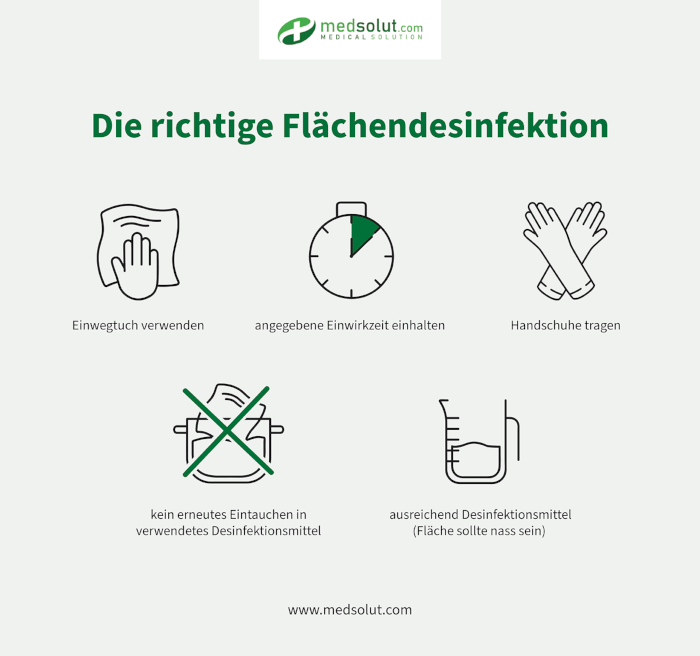
Disinfectant types: Inform thoroughly before buying
Disinfectants are an important component in the containment of disease. However, they often have downsides and can cause skin irritation or stains, for example. Moreover, not every substance is effective against all types of germs. Therefore, before using it, inform with reliable sources and choose a suitable agent. It is best to follow scientifically tested recommendations, e.g. the list of disinfectant types from the Robert Koch Institute, so you are definitely on the safe side.
FAQs on disinfectants in the private sector
In private everyday life, cleaning with disinfectant is usually not necessary. However, disinfection is useful for infectious diseases in the household (e.g. diarrheal diseases or COVID-19) and when dealing with immunocompromised persons.
As long as there are no infectious diseases in the household and no specially susceptible persons live there, washing hands with soap and water is sufficient. Incidentally, hand washing is also a highly effective means of preventing the spread of Corona. This is because the Sars-CoV-2 virus has a fatty envelope that is destroyed by the soap. But here too it is important: Wash for a sufficiently long time (20-30 seconds) and scrub hands firmly from all sides.
Most disinfectants require 30 seconds of exposure to achieve the desired effect. However, the exposure time depends on the specific disinfectant or the active ingredient. It is best to follow the manufacturer’s instructions (back of bottle or package insert).
Disinfecting substances include, for example, alcohols, chlorine, iodine or hydrogen peroxide. Depending on the intended use, some active ingredients are more suitable than others.
Expired disinfectant cannot be relied upon to be fully effective. For this reason, it should be disposed of and no longer used. However, it is usually not harmful.
Have comments or questions about the topic or want to share a topic suggestion for our upcoming posts as well as our YouTube channel? Then do not hesitate to contact us at any time. We openly accept your suggestions.
Graphics:Feel free to use and share the infographics. Please cite this post or medsolut.com as the source.
Cover image source: © Pattarisara – stock.adobe.com

